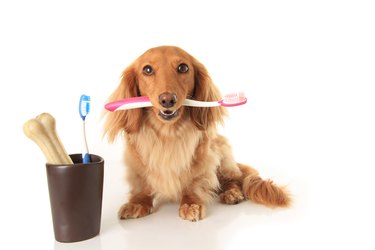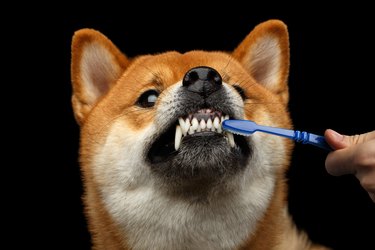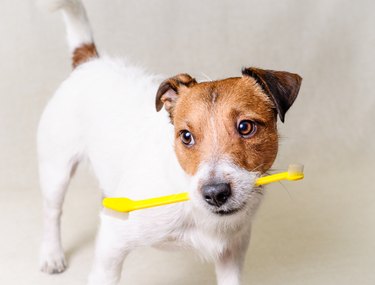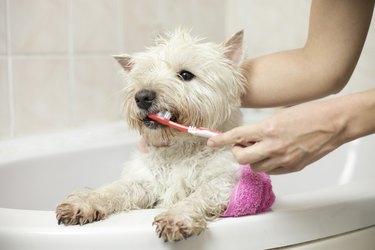Your dog has the cutest face! You can tell just what they're thinking when they look at you. Sometimes it even seems like they're smiling, right? And sometimes when they do, you can tell that their teeth need a good brushing. But, brushing your pet's teeth is definitely not as easy as brushing your own teeth.

Video of the Day
If you approach brushing your dog's teeth in a positive way, you can ensure that your dog will not only let you brush his teeth but will even enjoy it. All dogs can benefit from having their teeth cleaned. Teeth cleaning helps to prevent dental disease and maintain a dog's overall health.
Video of the Day
Health benefits of brushing your dog's teeth
Healthy teeth translate to a healthy mouth and healthy body and keep your dog's bad breath at bay. The American Veterinary Dental College says that tartar and plaque build up on dog's teeth just like on humans' teeth. Really bad teeth and dental health can lead to organ problems from bacteria which can travel from the mouth through the bloodstream.
Step 1. Gather your dental cleaning supplies
Never use human toothpaste. There are dog toothpastes made specifically for dogs that you should get, or you can make your own DIY dog toothpaste. Human toothpaste can irritate your dog's stomach. Most human toothpastes include fluoride, which is extremely poisonous to dogs. Some even include xylitol, which is also toxic to dogs.
You might think any toothbrush will do, but the American Kennel Club recommends a toothbrush specifically designed for canines. Dog-specific toothbrushes have a longer, curved handle that makes it easy to reach the back teeth. You can also use a dog toothbrush that is designed as a finger toothbrush.
Gather a towel to keep your work area clean. And since you'll want to reward your dog for his positive behavior toward the toothbrush, get your dog's favorite treats and or a favorite toy and keep them at hand.

Step 2: Introduce the dog toothbrush
Whether your dog is a puppy or an adult dog, introduce the dog toothbrush gently at first in your dog's mouth. Do this in a positive way using positive reinforcement dog training. Before you ever start brushing, show your dog the toothbrush and let them sniff the bristles. Plan ahead and pick the room in your house where you will be doing the brushing — like the bathroom, where you don't have to worry about toothpaste getting on the carpet. Choose a room where you have good lighting — and consider doing the introductions in that room so the association is made.
When they seem accepting of it, open their mouth and gently touch the toothbrush to their teeth. Don't do any actual brushing yet . . . just let them know that the toothbrush is touching their mouth. Praise your dog and give them a treat. Do this gentle introduction a few times until they get used to the idea of the toothbrush going in their mouth.
Step 3: Introduce the dog toothpaste
Put some toothpaste on your finger and let them sniff it. They may like it so much they lick it off, which is great! Put some toothpaste on the toothbrush and do the gentle introduction again.
Step 4: Introduce the idea of brushing to your dog
In step 2 you gently introduced the idea of the toothbrush going into their mouth. Now, after a couple of days of that, gently hold your dog's head and actually brush a tooth or two. Stop after a short time so they don't get upset. Praise them and give them a treat or reward.

The whole idea here is to let them know that toothbrushing doesn't hurt, and it's actually a fun way to get some attention from you and then they get a reward.
Step 5: Ready for brushing!
Gather all of your materials and move your dog to the room where you decided to do the brushing. Prepare your toothbrush and gently hold your dog's head. Maybe you only brush the front teeth and be sure to stop if your dog becomes agitated. Remember, the whole idea is to get them comfortable with the procedure.
Each time you brush, you can increase the time until eventually, you will be able to brush your dog's entire mouth. While you're brushing, use your calmest voice so your dog stays calm, and then make sure to give a treat right afterward.
Step 6: Teeth brushing procedure for dogs
Embrace Pet Insurance says to start by lifting your dog's upper lip up and brushing their front teeth. Take a short break and provide some praise. Brush again on the sides and all the way to the back, on both the top and bottom. When you get to the bottom teeth, hold down your dog's bottom lip and repeat the process you did on the top teeth.
Offer praise at each step and stop if you feel like your dog's good mood about brushing is changing. The AKC points out that brushing the inside of the teeth will be a little harder, so do this after your dog has accepted the whole procedure. The AKC even suggests giving your dog a treat at each step while you are brushing. Yes, you're trying to clean the teeth, and you and I would not eat while we are in the middle of brushing. But for your dog, it's all about making this a positive experience.

It may take a while for your dog to accept a daily dental hygiene routine, but the initial goal is to get them to be willing to let you brush their teeth. Then you can do it more often and combat the plaque and tartar build-up and maintain a healthy gum line. That way, you can prevent gingivitis, periodontal disease, and other dental health problems. If you are struggling to get your dog to accept you cleaning their teeth, you can also schedule a professional dental cleaning with your veterinarian. Though with patience, time, and positive reinforcement training, you can help provide your dog with basic oral health and dental care.
Always check with your veterinarian before changing your pet’s diet, medication, or physical activity routines. This information is not a substitute for a vet’s opinion.